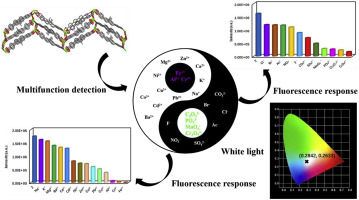Dyes and Pigments ( IF 4.1 ) Pub Date : 2019-09-05 , DOI: 10.1016/j.dyepig.2019.107862 Bing Li , Jun Zhou , Fengying Bai , Yongheng Xing

|
Based on the structural diversity and the superior luminescence properties of 4,4-(9,9-dimethyl-9H-fluorene-2,7-diyl) dibenzoic acid (H2DLDA), a series of new lanthanide coordination compounds [Ln(DLDA)(DMF)(H2O)(COO)]n (Sm (1), Eu (2), Ce (3), Nd (4), Gd (5)) were successfully prepared by the reaction of H2DLDA, which is a new type ligand synthesized by structural modification of fluorene, with rare earth metal ion. They were characterized by elemental analysis, IR, TG, PXRD, UV–vis, etc. Analysis results show that the coordination compounds are isomorphic. In particular, the structure of the coordination compound 1 was determined by single crystal X-ray diffraction. The structure analysis shows that compound 1 is a novel 3D supramolecular network structure, and the central metal adopts the eight-coordination mode to form a double-cap triangular prism spatial configuration. It is worth mentioning that the excellent heat-resisting ability of the framework, which is stable until heated to nearly 400 °C. Meanwhile, the fluorescence sensing test showed that as synthesized compound 2 was a new type of fluorescent probe with high efficiency, high selectivity and has the ability to simultaneously detect a variety of cations and anions (Fe3+, Al3+, Cr3+, C2O42−, Cr2O72−, MnO4−, PO43−). Moreover, it owns higher Ksv value (1.77 × 104 M−1, 1.44 × 104 M−1, 3.621 × 104 M−1, 2.07 × 103 M−1, 5.65 × 103 M−1, 3.18 × 103 M−1, 1.82 × 103 M−1, respectively) and a lower detection limit (1.93 μM, 2.38 μM, 0.945 μM, 16.5 μM, 6.06 μM, 10.8 μM, 18.8 μM, respectively). This results in compound 2 being superior to other probes reported previously, and the mechanism of fluorescence quenching was explained to some extent. In addition, during the fluorescence titration experiment, we found an interesting luminescence change of compound 2. Most notably, it emitted white light in DMA solvent under the irradiation of handheld ultraviolet lamp (wavelength: 365 nm) while the solid sample emitted yellow light at the same conditions.
中文翻译:

镧系元素-基于4,4-(9,9-二甲基-9H-芴-2,7-二基)二苯甲酸的有机骨架:同时合成,结构化和荧光检测多种阳离子和阴离子
基于4,4-(9,9-二甲基-9H-芴-2,7-二基)二苯甲酸(H 2 DLDA)的结构多样性和优异的发光性能,一系列新的镧系配位化合物[Ln(通过H 2反应成功制备了DLDA)(DMF)(H 2 O)(COO)] n(Sm(1),Eu(2),Ce(3),Nd(4),Gd(5))。DLDA是一种通过芴与稀土金属离子的结构改性合成的新型配体。它们通过元素分析,IR,TG,PXRD,UV-vis等进行了表征。分析结果表明,配位化合物是同构的。特别地,配位化合物1的结构通过单晶X射线衍射确定。结构分析表明,化合物1是一种新颖的3D超分子网络结构,中心金属采用八配位模式形成双帽三角棱柱空间构型。值得一提的是,框架具有出色的耐热能力,直到加热到接近400°C时才稳定。同时,荧光传感测试表明,作为合成化合物2是高效,高选择性的新型荧光探针,能够同时检测多种阳离子和阴离子(Fe 3+,Al 3+,Cr 3+,C 2 O 4 2-,Cr 2 O 7 2-,MnO的4 -,PO 4 3-)。此外,它拥有更高KSV值(1.77×10 4 中号-1,1.44×10 4 中号-1,3.621×10 4 中号-1,2.07×10 3 中号-1,5.65×10 3 中号-1,3.18×10 3 中号-1,1.82×10 3 中号-1分别)和分别检测下限(1.93μM,2.38μM,0.945μM,16.5μM,6.06μM,10.8μM,18.8μM, )。这导致化合物2优于先前报道的其他探针,并且在一定程度上解释了荧光猝灭的机理。此外,在荧光滴定实验中,我们发现了化合物2的有趣的发光变化。最值得注意的是,在手持紫外灯(波长:365 nm)的照射下,它在DMA溶剂中发出白光,而固体样品在相同条件下发出黄光。


















































 京公网安备 11010802027423号
京公网安备 11010802027423号